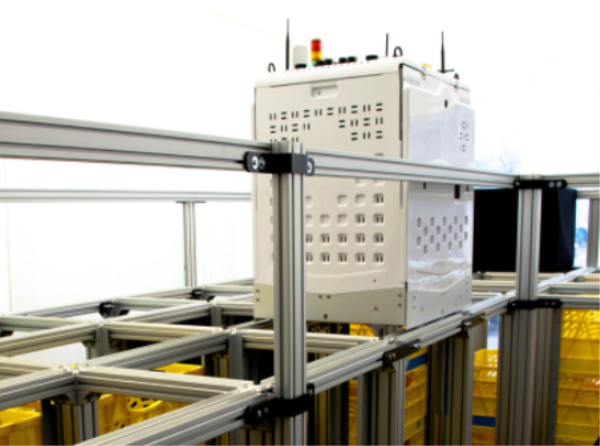28 November 2016

Ocado has 1,000 of these LTE-connected robots working at its highly automated warehouse.
Ocado, which claims to be the world’s largest online-only grocery retailer, has developed a unique 4G-based system to communicate with thousands of robots powering its new automated warehouses.
The firm claims that the wireless protocol it has developed guarantees a connection ten times per second to each of the more than 1,000 robots that are all working within a 150 metre radius at its warehouse.
According to Ocado, its system is the first time unlicensed 4G spectrum has been used for warehouse automation. However, the retailer has not detailed the specifics of its protocol.
Adam Green, Ocado’s wireless team leader, says: “We have worked closely with Cambridge Consultants to develop an innovative system that takes advantage of modern wireless communications principles, but has secret ingredients that tailor it to our specific environment.
“While building a robot can be a relatively straightforward task, creating a swarm of thousands of robots and making sure you can communicate with every single one in a tenth of a second is a whole different ball game.”
Green explains that the project was started three years ago and initially looked at the feasibility of using Wi-Fi. However, the technology was dismissed as a standard Wi-Fi network uses a distributed coordination function which, says Green, is not a deterministic means of guaranteeing latency.
He adds that there was also the issue of scale: “Most Wi-Fi APs can support a maximum of somewhere between 64 and 256 concurrent clients. Consider that we need to communicate with swarms of thousands of robots, talking to each ten times a second and with guaranteed latency.
“We needed to understand what this meant for the network design as well as how to accommodate it in an already busy spectrum plan.”
Using its experience of existing systems, Green said Ocado knew that it should enable a maximum of around 80 clients per AP and reduce the cell size to a very small area.
“This is similar to the approaches taken in high density deployments such as sports stadiums and auditoriums. However, unlike in those areas, the clients would be constantly moving and using the Wi-Fi network as their primary activity, rather than watching the sports game or concert. There is relatively little headroom above the bots, providing a further driver for many small cells.”
Another reason why Wi-Fi would not work was because roaming would be required between APs which, says Green, is notoriously unpredictable: “The best results we see in the real world are around 300ms, which would impact the command and control of traffic.”
The final nail in the coffin for Wi-Fi as far as Ocado’s needs were concerned is that it would require complex planning and installation work for each warehouse, which would prove expensive and difficult to maintain.
“Ultimately, we found that Wi-Fi’s non deterministic performance would hinder our ability to develop an efficient real time control algorithm for the bots,” says Green. “Resolving this problem was therefore critical to the success of the overall project.”
The result was a new wireless protocol based on mobile LTE technology. Since the protocol works in the license-free spectrum, Green says Ocado can also deploy it at a moment’s notice in any location around the world.
The company will use the system at its highly-automated warehouses which will be offered as part of a managed service called the ‘Ocado Smart Platform’. This has been designed to enable international partners to build scalable, sustainable and profitable online retail businesses.
However, Ocado says the wireless protocol can be re-purposed for other IoT applications that require low latency communications between multiple devices, such as vehicle-to-vehicle connectivity for smart cars, air traffic control systems or large scale industrial systems.
Green says Ocado will continue to develop the system.
“We haven’t finished yet. By designing this system ourselves, we’re free to alter and add features as we see fit. Soon we’ll be analysing how alternate MAC layers could help improve warehouse efficiency, and designing a custom roaming algorithm optimised for our specific application.”










